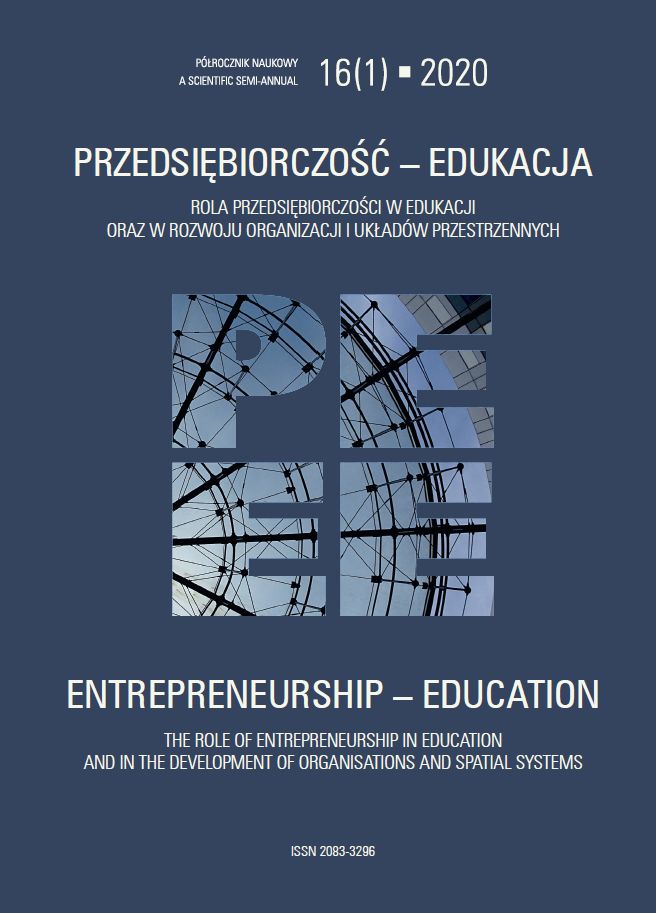Development of Mobile Payment Services in Small and Medium Enterprises
DOI:
https://doi.org/10.24917/20833296.161.26Keywords:
development, determinants, mobile payments, SME enterprisesAbstract
The aim of the study was to determine the reasons for implementing non-cash payment services in small and medium enterprises, with focus on mobile payments. The basis of the study were secondary and primary data. Data were obtained from the reports of the National Bank of Poland, Polish Financial Authority, Central Statistical Office, payment card systems. The research period covered the years 2015-2019. In order to examine SME enterprises decisions regarding the introduction of mobile payment methods carried out were surveys inspired by the technology acceptance theory model. As the analysis showed more entrepreneurs notice the growing market demand for mobile payments and changes in surrounding environment. Customers’ interest in this form of payment were of great importance. The changes are due to the awareness of entrepreneurs of the need to change business strategies. Enterprises that implemented mobile payments treated these activities as increasing their competitive position. The rank of these factors were high in the hierarchy of grades obtained. The greater activity in the implementation of mobile payments occurs in medium-sized enterprises. For small businesses the element stimulating openness to changes is the customers’ withdrawing from making purchases. The location of business activity correlated with the number of potential customers positively stimulates the active approach of entrepreneurs to modern forms of payment and the increased acceptance of these payments.
References
Borcuch, A. (2007). Pieniądz elektroniczny – pieniądz przyszłości. Analiza ekonomiczno-prawna. Warszawa: CeDeWu.
Chmielarz, W. (2004). Analiza porównawcza systemów płatności w handlu elektronicznym. W: J. Kisielnicki (red.), Informatyka narzędziem współczesnego zarządzania. Warszawa: Wydawnictwo Naukowe PJWSTK.
Chmielarz, W. (2005). Systemy elektronicznej bankowości. Warszawa: Difin.
Czarny, B. (2018). Podstawy ekonomii. Warszawa: PWE.
Davis, F. (1989). Perceived usefulness, perceived ease of use and user acceptance of information technology. MIS Quarterly, 13, 45–50.
Eftekhari, N., Bogers, M. (2015). Open for entrepreneurship: How open innovation can foster new venture creation. Creativity and Innovation Management, 24(4), 574–584.
Filip, P. (2017). Development of individual entrepreneurship in Poland under crisis conditions. Ovidius University Annals. Economic Sciences Series, XVII(1), 484–479.
Ghobakhloo, M., Arias-Aranda, D., Benitez-Amado, J. (2011). Adoption of e-commerce applications in SMEs. Industrial Management and Data Systems, 111(8), 1238–1269. doi: 10.1108/02635571111170785
GUS. (2019). Społeczeństwo informacyjne w Polsce. Wyniki badań statystycznych z lat 2012–2018. Warszawa: GUS.
Hossain, M. (2015). A review of literature on open innovation in small and medium-sized enterprises. Journal of Global Entrepreneurship Research, 5(1), 6.
IPSOS dla Fundacji Rozwoju Obrotu Bezgotówkowego. (2017). Postawy i zachowania przedsiębiorców z sektora MŚP wobec obrotu bezgotówkowego. Raport z badania. Warszawa: IPSOS dla Fundacji Rozwoju Obrotu Bezgotówkowego.
Kim, Y., Choi, J., Park, Y.J., Yeon, J. (2016).The adoption of mobile payment services for finch. International Journal of Applied Engineering Research, 11(2), 1058–1061.
Kozakiewicz, M., Kwas, M. (2014). Prognoza wybranych wskaźników rozwoju obrotu bezgotówkowego na lata 2014–2020. Warszawa: Szkoła Główna Handlowa, NBP.
Maciejewski, K., Polasik, M. (2019). Innowacyjne usługi płatnicze w Polsce i na świecie. Materiały i Studia NBP, 241, 19–22.
NET@bank, Związek Banków Polskich (2019, 10 września). Raporty: Bankowość internetowa i płatności bezgotówkowe. Pozyskano z: https://www.zbp.pl/raporty-i-publikacje/raporty-cykliczne/raport-netbank
NBP. (2019, 10 września). Informacja o kartach płatniczych. Dane z lat 2015–2018. Pozyskano z: https://www.nbp.pl/
Pacak, M. (2014). Usługi płatnicze. Komentarz. Warszawa: LexisNexis.
Pearson, J.M., Grandon, E. (2006). An empirical study of factors that influence E-commerce adoption/non-adoption in small and medium sized businesses. Journal of Internet Commerce, 4(4), 1–21. doi: 10.1300/J179v04n04_01
Raport Mastercard (2019). Przedsiębiorca w bezgotówkowym świecie. Pozyskano z: https://newsroom.mastercard.com
Szmigielska, B., Wolski, K., Jaszczak, A. (2012). Modele wyjaśniające zachowania użytkowników internetu. E-mentor, 3(45).
Ustawa z dnia 12 września 2002 r. o elektronicznych instrumentach płatniczych. Dz.U. nr 169 z 2012 r., poz. 1232 ze.zm.
Ustawa z dnia 19 sierpnia 2011 r. o usługach płatniczych. Dz.U. z 2019 r., poz. 659, 730 i 1495.
Ustawa z dnia 10 maja 2018 r. o zmianie ustawy o usługach płatniczych oraz niektórych innych ustaw. Dz.U. z 2018 r., poz. 1075.
Ustawa z dnia 6 marca 2018 r. Prawo przedsiębiorców. Dz.U. z 2018 r., poz. 646.
Downloads
Published
How to Cite
Issue
Section
License
Articles are published under the terms of the Creative Commons License (CC BY-ND 4.0; Attribution– NoDerivs).

